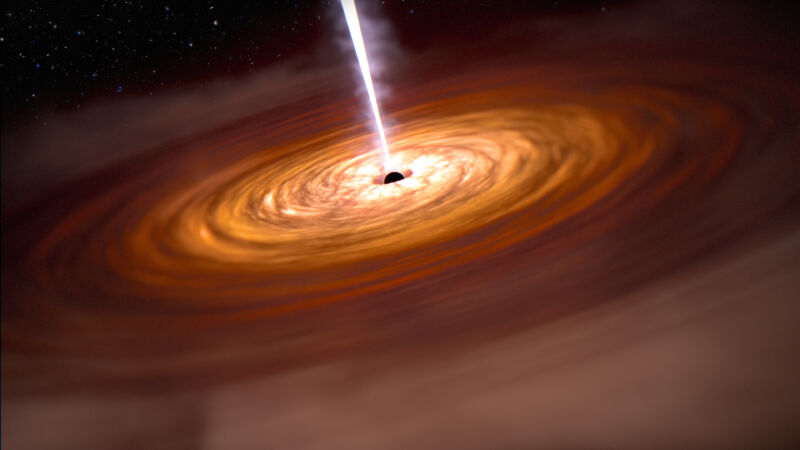
Supermassive black holes appear to be at the center of every galaxy, dating back to some of the earliest galaxies in the Universe. And we don’t know how they got there. It shouldn’t be easy for them to grow from supernova remnants to massive sizes as quickly as they do. And we don’t know of any other mechanism that could create something large enough that massive growth wouldn’t be necessary.
The apparent impossibility of supermassive black holes in the early Universe was already a bit of a problem; The James Webb Space Telescope has made it even worse by finding early instances of galaxies with supermassive black holes. In the latest example, researchers have used Webb to pinpoint a quasar powered by a supermassive black hole as it existed about 750 million years after the Big Bang. And it looks surprisingly normal.
Looking back in time
Quasars are the brightest objects in the Universe, powered by supermassive black holes. The galaxy around them feeds them enough material that they form bright accretion disks and powerful jets, both of which emit a lot of radiation. They are often covered in dust, which glows from absorbing some of the energy emitted by the black hole. These quasars emit so much radiation that they eventually drive some of the nearby material out of the galaxy altogether.
Therefore, the presence of these elements in the early Universe would tell us that supermassive black holes not only existed in the early Universe but also merged into star clusters as they are in more recent times. But it has been very difficult to read them. To begin with, we have not recognized many; there are only nine quasars that date back to when the Universe was 800 million years old. Because of that distance, the elements are difficult to resolve, and the red shift caused by the expansion of the Universe absorbs intense UV radiation from many elements and stretches it into the infrared.
However, the Webb telescope was specifically designed to detect objects in the early Universe by being sensitive to the infrared wavelengths at which this radiation is emitted. So, the new study is based on pointing Webb at the first of the nine early discoveries, J1120+0641.
And it seems … surprisingly normal. Or at least as many as quasars from more recent periods in the history of the Universe.
More common
The researchers analyze the continuum of radiation emitted by the quasar, and find clear indications that it is embedded in a hot, dusty donut of material, as seen in later quasars. This dust is hotter than in some of the more recent quasars, but that seems to be a common feature of these objects at earlier stages in the history of the Universe. Radiation from the accretion disk is also visible in the emission spectrum.
Various methods for estimating the mass-produced values of black holes in the region 10.9 times the mass of the Sun, and exposed it in the vast region of the black hole. There is also evidence, from slight changes in some of the rays, that the quasar is blasting material at 350 kilometers per second.
There are a couple of oddities. One is that the material also seems to be falling in at about 300 kilometers per second. This can be caused by material spinning away from us on the accretion disk. But if so, it should match the material moving towards us on the other side of the disc. This has been observed a few times in very early quasars, but the researchers admit that “The physical origin of this effect is unknown.”
One option they suggest as an explanation is that the entire quasar is moving, pulled out of its position at the center of the galaxy by a previous merger with another supermassive black hole.
Another unusual feature is that there is also a very fast stream of ionized carbon – moving at about twice the speed as it does in quasars at later times. This has been seen before, but there is no explanation for it, either.
How did this happen?
Despite the unusual nature, this object looks like quasars in recent times: “Our observations show that the complex structures of the dusty torus and [accretion disk] they can establish themselves around a [supermassive black hole] less than 760 Myr after the Big Bang.”
And again, that’s a bit of a problem since it points to the existence of a supermassive black hole attached to its star cluster very early in the history of the Universe. To reach the kind of size seen here, black holes push against what’s called the Eddington limit—the amount of material they can draw on before the radiation emitted by doing so washes away the surrounding material, eating away at the black hole.
That suggests two options. One is that these objects absorbed material beyond the Eddington limit for most of their history—something we haven’t seen and something that isn’t true of this quasar. Another option is that they started in large numbers (about 104 times the mass of the Sun) and continue to feed at a more satisfactory rate. But we don’t know how big something can form.
Thus, the early Universe remains a confusing place.
Nature Astronomy, 2024. DOI: 10.1038/s41550-024-02273-0 (About DOIs).
#Black #holes #formed #quasars #billion #years #Big #Bang